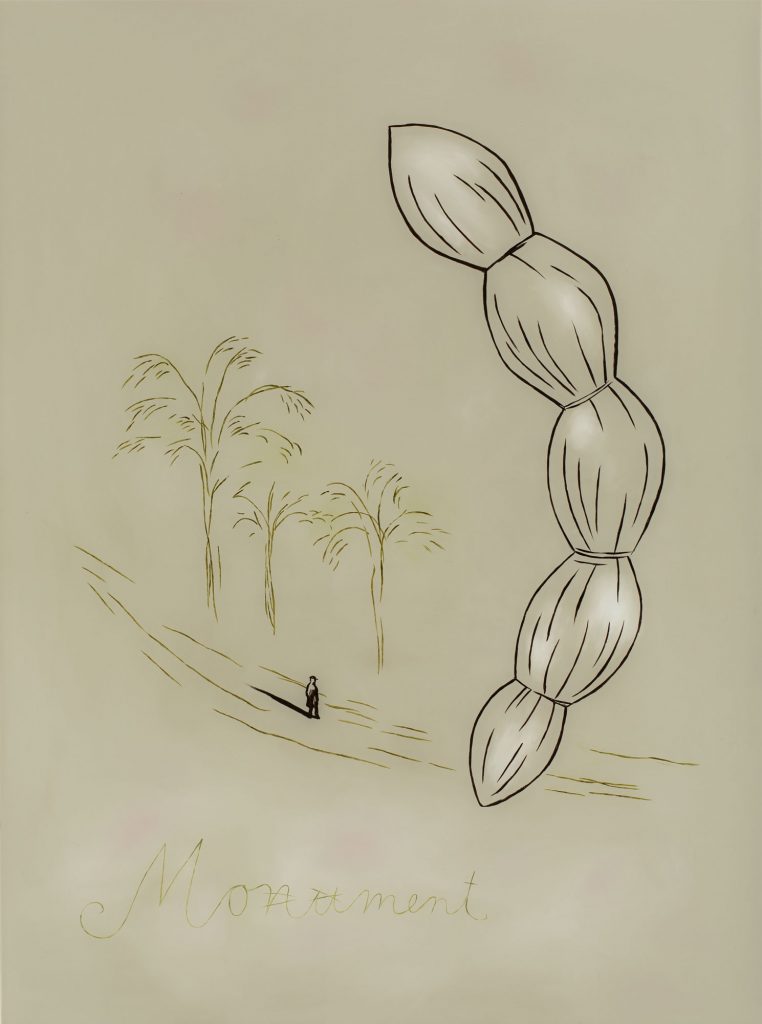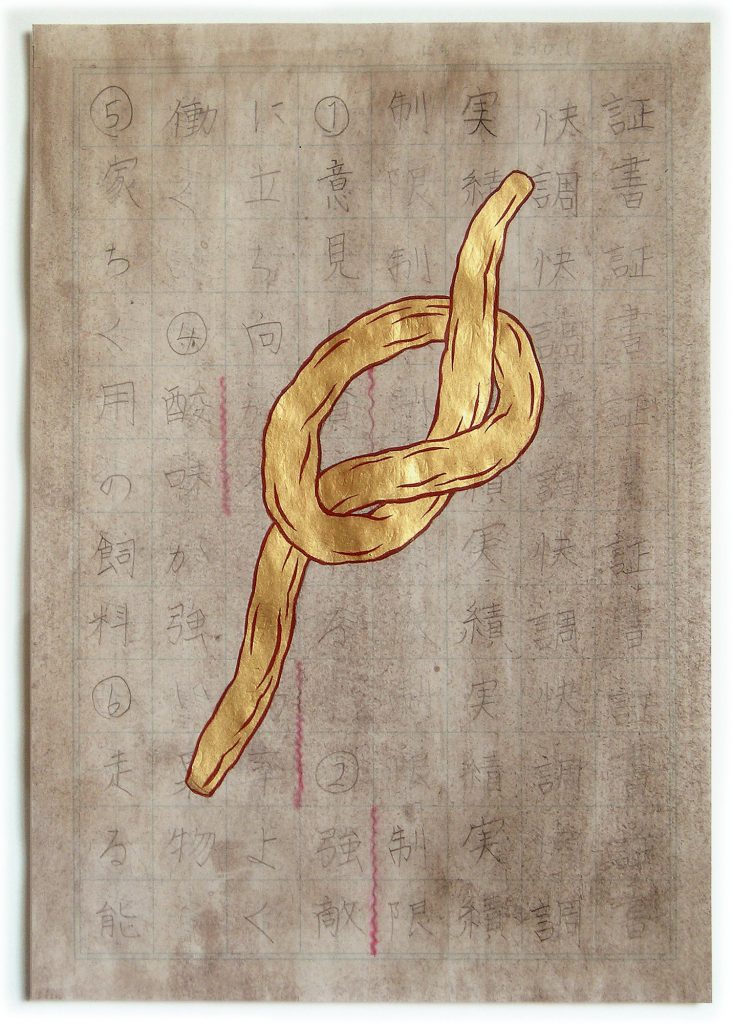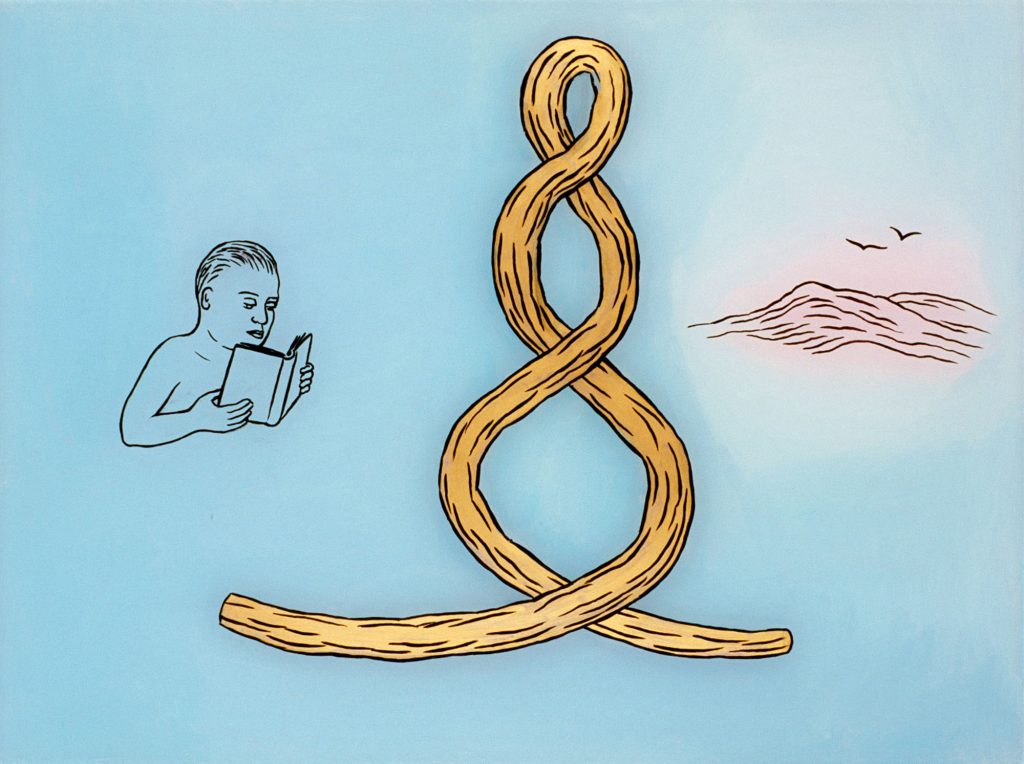Rainer Beßling 2020
Worlds of Thought and Thinking the World
On the Branches, Bundles and Heaps of Veronika Dobers
“Cosmos, earth, man“ is the title of a short poem by Veronika Dobers that unfurls the subjects of her art. She states:
“the cosmos gigantic
the earth very small
man is so tiny
and wants to stand tall
he hunts and gathers
from the very beginning
bends, bundles and heaps
always ready for winning.“
The artist views nothing less than the nature of existence in simple diction and on a laconic note and breaks these down into frugal scenes and into a clear language of form in her pictures. In these we encounter the confined being and the unlimited eagerness of man in a boundless universe of emblematic figurations and monochromatic colour spaces. Beyond time and space always the same pattern: a pursuit, a gathering, an endless struggle. The artist finds concise objects for this configuration. Branches, bundles and heaps appear allegorically as companions of man. Branches represent organic material in their natural state and civilisational use. They represent man, who does not only try to control nature, but also tries hard with all his might to find his place in the world. This leads to associations with a tree as it grows naturally and how it is used by man. The bundle is standing in an intermediate state as a resource for cultural activity as well as for concentrated spiritual energy and inner mental state.

Veronika Dobers prefers to use the English word “heap” instead of the German word “Haufen”. It sounds clearer and more concise and makes the upward movement and the idea of a pointed elevation even more evident. The heaps fill the space like solitary monuments, they merge into a winter landscape, they place themselves in front of writing exercises or mingle with plants.They are a mixture of landscape features and abstract symbols that speak of nature and culture, ambitions and earnings, creations and education that man puts in the world and that he encounters as alien, mysterious beings in physical form. Drops are also a further figurative element. They float from the sky as “physical phenomena“ like monumental rain, sometimes light, sometimes dark, representing both shadow and light. They fly with the wind, submerge in the river, crash against houses, crawl on the ground. They trace the water’s flow, the cycle of nature in the inhabited surroundings. They are kicked and hit, caught and gathered as an essential part of human needs. They are not only a physical phenomenon but also a poetical event. They speak visually about an interaction with nature, populating a landscape and also about dreams and tales. When drops appear in front of a woman’s face who seems to be sleeping or is lost in thought, the physical phenomena then receive a resonating space in the imagination of people, a kind of thinking that contrasts the outer world with a visual and conceptual order.
Dobers’ pictures are about thoughts and ways of thinking, the search for knowledge and the self. This is about real existence and images of life depicted in comic-style manner similar to diagrams of nature studies. The artist portrays her protagonists deliberately impersonal and neutral. They are genderless, universal, archetypal. They are totally tangible in their littleness and totally extensive in their ambitions. The artist emphasizes this enculturation by using pages from exercise books. In the series School, in which writing exercises of an 11-year-old schoolgirl served as a basis, there is a knotted branch that interchanges between complying with and escaping from its original shape. A tree can be seen in the shape of a candelabra, something that would not exist naturally. The tension between natural growth and cultivation takes shape here. The exercise book extends the meaning; the configuration also refers to the schooling and education of people, distinctiveness develops into cultural standards.

At the beginning of 2010 Veronika Dobers took part in an art project in Iwami, a village in the prefecture Tottori by the Japanese Sea. The title was Man and Nature, a subject that Veronika Dobers was already principally interested in before her stay in Japan. She was not only interested in it on a global level but put her works in a direct regional context on both a conceptual and technical level. Among other things, she used paper for her drawings that is used to cover traditional windows. While exploring the village she discovered a sculpture of a schoolboy in traditional Japanese clothes. This figure reminded Veronika Dobers of a subject in one of her earlier works: a kind of man-child sitting on a chair observing abstract fundamental goings-on in the world. The little man who is the protagonist in the introductory poem.

Dobers‘ protagonists wander through sparse landscapes. They often appear isolated, lonely, dropped into their being. They roam, row, scurry through the world, a short appearance, an intermezzo. They try to leave traces, cut through, find their way, settle down. Man stands between the open, public, and the private, cosy, torn between the near and the distant. In one picture the protagonist points to a bird, flying freely beyond all limits in the sky. He has a hard time trying to decide between his roots and bonds and the open world. Every moment of life is a moment of decision-making. Every decision needs consideration and is a risk. Point of Decision is the title of a work in which a rower has to decide between two parallel worlds.
Veronika Dobers captures thoughts as ways of being in pictures between short story and aphorism. They reveal themselves as imaginations, they are results of intellectual work. Play and stringency correspond with each other. The void and blanks also have something to say. They reflect that consciousness cannot be entirely represented. Silence rules in Veronika Dobers‘ pictures, time stands still. The flat monochromatic image spaces create an assembled atmosphere. The incidence is prolonged, the present is permanent for the beholder. Behind the bare scenes, which stand like a doorway on the foremost edge of the picture, virtual worlds open up. The image space is filled with the reverberation of the scenes: an echo chamber which brings atmosphere into the event.
With reverse painting on acrylic glass and drawing, Veronika Dobers uses two techniques that are actually in opposition to each other. On the one hand a painting process that needs exact planning and, on the other hand, the artistic process that is said to be the most spontaneous and truthful. The artist shows that in both techniques both variants are possible. In a series of drawings with the title Hirngespinste she puts graphical loops precisely but without compositional plan and without control on paper. Thinking, in a form-orientated conceptual sense seems excluded here, instead something attaches itself to the paper, a short circuit between image and hand that shows the sweeping movement of her hand. In other drawings a precise arrangement can be seen, the metaphorical urgency of Veronika Dobers‘ works would not be possible without formal focus. Here drawing documents the force of contouring which is based on compression of thoughts and graphical concentration. In reverse painting on glass the already mentioned spontaneous and – as a result – sketchy-looking works can be found. They have a special atmosphere, archaic, almost naïve when genuine and natural view is meant. The majority of the reverse glass paintings are results of a complicated and complex process that demands a special way of thinking and imagination. The motives are applied reversed with oil paint on the back of an acrylic glass panel. This technique creates impressions that have manifold equivalents in the image contents. Just as in the scenes the concrete and the abstract, space and surface, concretion and cipher meet, the image carrier is window and wall, painted surface and varnish at the same time.
Veronika Dobers speaks of basic things in simple, elementary language, precise and reduced. She brings things to the point or more precisely to the line. Her stroke is timeless, it seems neutral and still has the character of personal handwriting. It appears historical, has classicism. The idea is controlled, tamed and formed. Figuration and colour correspond intensely and vividly. The composition is clear, equilibrated. There is a balance between content and form, but the cryptic peeks through a gap, the uncontrollable, untamed, that swings along and exposes nature and what is natural about man. Veronika Dobers’ art is beautiful because it is lucid and genuine. It is graceful and fragile, but still determined and explicit. The disclosed content lies in the determination of the form and in the strict bundling of the content. At the same time the forms allow mysteries and secrets. They demonstrate their own vivacity to the paradigms of learning and didactic.